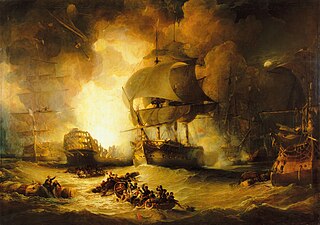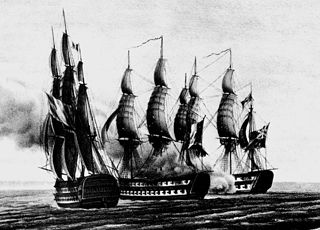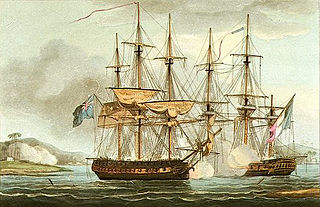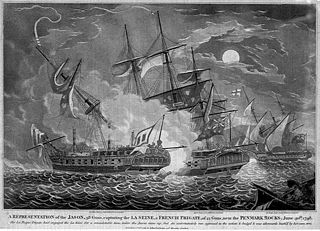
The Battle of the Nile was a major naval battle fought between Britain's Royal Navy and the French Republic Navy at Aboukir Bay on the Mediterranean coast off the Nile Delta of Egypt between 1–3 August 1798. The battle was the climax of a naval campaign that had raged across the Mediterranean during the previous three months, as a large French convoy sailed from Toulon to Alexandria carrying an expeditionary force under General Napoleon Bonaparte. The British fleet was led in the battle by Rear-Admiral Sir Horatio Nelson; they decisively defeated the French under Vice-Admiral François-Paul Brueys d'Aigalliers, destroying the best of the French navy, which was weakened for the rest of the Napoleonic Wars.

HMS Phoebe was a 36-gun fifth rate of the Royal Navy. She had a career of almost twenty years and fought in the French Revolutionary Wars, the Napoleonic Wars and the War of 1812. Overall, her crews were awarded six clasps to the Naval General Service Medals, with two taking place in the French Revolutionary Wars, three during the Napoleonic Wars and the sixth in the War of 1812. Three of the clasps carried the name Phoebe. During her career, Phoebe sailed to the Mediterranean and Baltic seas, the Indian Ocean, South East Asia, North and South America.

HMS Speedy was a 14-gun Speedy-class brig of the British Royal Navy. Built during the last years of the American War of Independence, she served with distinction during the French Revolutionary Wars.

HMS Swiftsure was a 74-gun third rate ship of the line of the British Royal Navy. She spent most of her career serving with the British, except for a brief period when she was captured by the French during the Napoleonic Wars in the action of 24 June 1801. She fought in several of the most famous engagements of the French Revolutionary and Napoleonic Wars, fighting for the British at the Battle of the Nile, and the French at the Battle of Trafalgar.

Africaine was one of two 40-gun Preneuse-class frigates of the French Navy built to a design by Raymond-Antoine Haran. She carried twenty-eight 18-pounder and twelve 8-pounder guns. The British captured her in 1801, only to have the French recapture her in 1810. They abandoned her at sea as she had been demasted and badly damaged, with the result that the British recaptured her the next day. She was broken up in 1816.

Jean-Baptiste Philibert Willaumez was a French Navy officer and nobleman who served during the French Revolutionary and Napoleonic Wars. Willaumez joined the French navy at the age of 14, and proved to be a competent sailor. Having risen to the rank of pilot, he started studying navigation, attracting the attention of his superiors up to Louis XVI himself. Willaumez eventually became an officer and served under Antoine Bruni d'Entrecasteaux in his expedition to rescue Jean-François de Galaup, comte de Lapérouse and explore the Indian Ocean and Oceania.
Admiral Sir Robert Barlow GCB was a senior and distinguished officer of the British Royal Navy who saw extensive service in the American Revolutionary War, the French Revolutionary Wars and the Napoleonic Wars. He made his name in small ship actions, especially fighting French frigates, of which he captured three. In his later career Barlow served as comptroller of the Navy and was influential at the Admiralty right up to his death. Although born to a middle-class family, Barlow and his siblings made names for themselves and two of Barlow's daughters married into the naval aristocracy. His grandson, Robert Barlow, was a first-class cricketer and army officer.
The action of 13 September 1810 was an inconclusive frigate engagement during the Napoleonic Wars between British Royal Navy and French Navy frigates during which a British frigate was defeated by two French vessels near Isle de France, but British reinforcements were able to recapture the ship before the French could secure her. The British frigate was HMS Africaine, a new arrival to the Indian Ocean. She was under the command of Captain Robert Corbet, who had served there the previous year. Corbet was a notoriously unpopular officer and his death in the battle provoked a storm of controversy in Britain over claims that Corbet had either committed suicide at the shame of losing his ship, been murdered by his disaffected crew, or been abandoned by his men, who were said to have refused to load their guns while he remained in command. Whether any of these rumours were accurate has never been satisfactorily determined, but the issue has been discussed in several prominent naval histories and was the subject of at least one lawsuit.
Captain Robert Corbet RN, often spelled Corbett, was an officer of the British Royal Navy during the French Revolutionary and Napoleonic Wars who was killed in action in highly controversial circumstances. Corbet was a strict disciplinarian who regularly beat his men for the slightest infractions: so brutal was his regime that he provoked two mutinies, one simply at the rumour he was coming aboard a ship. These uprisings caused him to become even more vicious in his use of punishments and when he took the frigate HMS Africaine into action off Île Bourbon in September 1810, his men failed to support him and may even have murdered him. In addition to his obsession with discipline and obedience, Corbet was regarded as an inefficient commander, whose standards of gunnery and training were so poor that when his ship did go into action it was ill-equipped to fight the French frigates stationed in the Indian Ocean.

HMS Dido was one of the twenty-seven Enterprise class of 28-gun sixth-rate frigates in service with the Royal Navy during the late eighteenth and early nineteenth centuries. Dido was commissioned in September 1787 under the command of Captain Charles Sandys. She participated in a notable action for which her crew would later be awarded the Naval General Service Medal; her participation in a campaign resulted in the award of another. Dido was sold for breaking up in 1817.

Régénérée was a 40-gun Cocarde-class frigate of the French Navy. The British captured her in 1801 at the fall of Alexandria, named her HMS Alexandria, sailed her back to Britain, but never commissioned her. She was broken up in 1804.

The action of 31 March 1800 was a naval engagement of the French Revolutionary Wars fought between a Royal Navy squadron and a French Navy ship of the line off Malta in the Mediterranean Sea. By March 1800 Valletta, the Maltese capital, had been under siege for eighteen months and food supplies were severely depleted, a problem exacerbated by the interception and defeat of a French replenishment convoy in mid-February. In an effort to simultaneously obtain help from France and reduce the number of personnel maintained in the city, the naval commander on the island, Contre-amiral Pierre-Charles Villeneuve, ordered his subordinate Contre-amiral Denis Decrès to put to sea with the large ship of the line Guillaume Tell, which had arrived in the port shortly before the siege began in September 1798. Over 900 men were carried aboard the ship, which was to sail for Toulon under cover of darkness on 30 March.

The action of 20 October 1793 was a minor naval engagement of the French Revolutionary Wars fought off Cape Barfleur on the French coast of the English Channel. The early months of the war, which had begun in February, had seen a number of French frigates raiding British merchant shipping in the Channel, and HMS Crescent under Captain James Saumarez was deployed to watch the port of Cherbourg-en-Cotentin with the aim of disrupting the operations of the French frigates Réunion and Sémillante that were based in the harbour. On 20 October, Saumarez was waiting off Cape Barfleur for French movement when his lookout sighted Réunion and the cutter Espérance approaching from open water.
Jean-Jacques Magendie was a French Navy officer. He famously captained the flagship Bucentaure at the Battle of Trafalgar.

Ganteaume's expeditions of 1801 were three connected major French Navy operations of the spring of 1801 during the French Revolutionary Wars. A French naval squadron from Brest under Contre-amiral Honoré Ganteaume, seeking to reinforce the besieged French garrison in Ottoman Egypt, made three separate but futile efforts to reach the Eastern Mediterranean. The French army in Egypt had been trapped there shortly after the start of the Napoleonic campaign in Egypt in 1798, when the French Mediterranean Fleet was destroyed at the Battle of the Nile. Since that defeat, the French Navy had maintained only a minimal presence in the Mediterranean Sea, while the more numerous British and their allies had succeeded in blockading and defeating several French bases almost unopposed.

The action of 24 June 1801 was a minor naval engagement during the French Revolutionary Wars. A British ship of the line, HMS Swiftsure under Captain Benjamin Hallowell was passing westwards through the Southern Mediterranean near Cape Derna when it encountered a much larger French squadron under Contre-Amiral Honoré Ganteaume that was also returning westwards after a failed attempt to reinforce the besieged French garrison in Egypt. Although Hallowell immediately recognised the danger his vessel was in and turned to flee, the French ships were much faster and soon closed with his ship. At 14:00, three French vessels were within long gunshot and Hallowell decided that his only hope of escape lay in disabling the three ships before the rest of the French squadron could join the engagement. Turning towards the enemy, Hallowell found that his sluggish ship was unable to respond rapidly to French manoeuvres and within two hours Swiftsure was surrounded. Threatened with complete destruction and unable to escape, the British captain surrendered.

The action of 6 May 1801 was a minor naval engagement between the 32-gun xebec-frigate El Gamo of the Spanish Navy under the command of Don Francisco de Torres and the much smaller 14-gun brig HMS Speedy under the command of Thomas, Lord Cochrane. El Gamo was captured despite being four times as large, with much greater firepower and a crew six times the size of Speedy, which had a reduced crew of 54 at the time of the engagement.

The Algeciras campaign was an attempt by a French naval squadron from Toulon under Contre-Admiral Charles Linois to join a French and Spanish fleet at Cadiz during June and July 1801 during the French Revolutionary Wars prior to a planned operation against either Egypt or Portugal. To reach Cadiz, the French squadron had to pass the British naval base at Gibraltar, which housed the squadron tasked with blockading Cadiz. The British squadron was commanded by Rear-Admiral Sir James Saumarez. After a successful voyage between Toulon and Gibraltar, in which a number of British vessels were captured, the squadron anchored at Algeciras, a fortified port city within sight of Gibraltar across Gibraltar Bay. On 6 July 1801, Saumarez attacked the anchored squadron, in the First Battle of Algeciras. Although severe damage was inflicted on all three French ships of the line, none could be successfully captured and the British were forced to withdraw without HMS Hannibal, which had grounded and was subsequently seized by the French.

The Battle of Mahé was a minor naval engagement of the last year of the French Revolution, fought on 19 August 1801 in the harbor of Mahé in the Seychelles, a French colony in the Indian Ocean. Since the demise of the French Indian Ocean squadron in 1799, the Royal Navy had maintained dominance in the East Indies, controlling the shipping routes along which trade flowed and allowing the rapid movement of military forces around the theatre. French First Consul Napoleon Bonaparte had long-harboured ambitions of threatening British India, and in 1798 had launched an invasion of Egypt as an initial step to achieving this goal. The campaign had failed, and the French army in Egypt was under severe pressure by early 1801, partly due to the presence of a British squadron acting with impunity in the Red Sea.

The action of 30 June 1798 was a minor naval engagement fought along the Biscay coast of France during the French Revolutionary Wars. The French Navy had been largely driven from the Atlantic Ocean early in the war following heavy losses in a series of failed operations. This had allowed the Royal Navy's Channel Fleet to institute a close blockade on the French naval ports of the Biscay coast, particularly Brest in Brittany. The blockade strategy included a constantly patrolling inshore squadron composed of frigates, tasked with preventing the passage of French ships into or out of the port. In the spring of 1798, several French frigates stationed in the Indian Ocean were sent back to France as the base at Île de France could no longer supply them effectively. One of these ships was the 40-gun frigate Seine, which departed Port Louis laden with 280 soldiers from the garrison.














